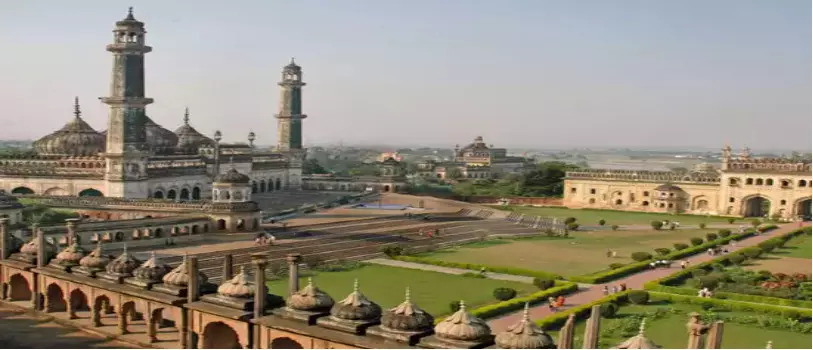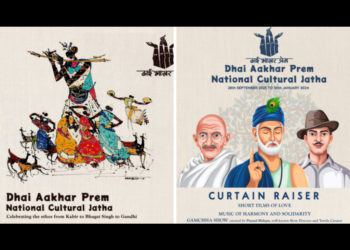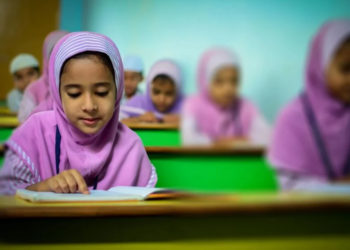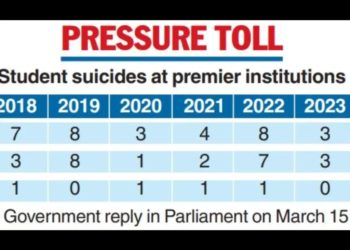
Lucknow is in the midst of multiple festivities. It is Navratri, and the time to worship Durga as well. The different communities from across the country, who have been living in the city for generations, are celebrating festivals in their own unique way.
The city has bid goodbye to the scorching heat of the summer, and the humidity of the monsoons. It is time to enjoy the balmy days now.
Most citizens are in the habit of shelving their respective religions to concentrate on celebrating life with each other. It is not unusual to find devotees of the goddess Durga amongst Muslims, or lovers of Imam Husain amongst practising Hindus. The word ‘garba’ means womb and dancers pay respect to the prowess of the Goddess to create life in the womb, by energetically swinging to life-enforcing music in large groups.
Traditions of togetherness amongst all citizens of the city have come down from rulers who had practised the same in the past.
It was in the late 18th Century that Lucknow was transformed from a rustic wholesale granary into a world class capital.
The key that had turned Lucknow into a paradise on earth was the joint effort of both the prince and pauper to consistently share whatever they owned, with each other. The generosity and far-sight of most rulers in the 19th Century is legendary as is their love for the people and the land that they had ruled.
The miraculous makeover of Lucknow to heights more marvellous than the capital of the Ottoman rulers of Istanbul happened because of the pride that each citizen had held for the city.
Boundless wealth from agricultural activities had made the world envy the trade and economy of Lucknow in the 19th Century.
It was the magnanimity of the rulers of the time really, that sowed the seeds of a grand cultural renaissance. The majority population of the city was engaged in this way of life and bits and pieces of that togetherness continues to pop up amidst the heap of a great ruin which the city is reduced to today.
Watching Asafudaula play Holi with citizens towards the end of the 18th Century had made Urdu poet Mir Taqi Mir wonder at the ebullience of the ruler of Lucknow during the festival of colours that had made children as well as adults so happy, “Holi khelien Asafudaula wazir, rang sohbat se ajab haiin khurd-o-pir“.
Asafudaula’s brother and successor Saadat Ali Khan continued to spend lavishly on Holi and Dussehra celebrations to the utter delight of citizens. It was a much looked forward to ritual to wait for Wajid Ali Shah, the last ruler of Lucknow to perform on stage at both the Ramleela and the Janamashtami public shows held in the open air.
Wajid Ali Shah was a devotee of Krishna and loved to play the role of the avatar of Vishnu, the preserver of life on stage. When Wajid Ali Shah was dethroned by the British in 1956, the citizens of Lucknow were told that their beloved king was travelling to London. Soon after the news spread, the streets of the city had echoed with recitations of prayers to Rama to take care of Wajid Ali Shah, “Hazrat jaatein haiin London, kripa karo Raghunandan…”
It was Nasiruddin Haider, ruler of Lucknow between 1827 and 1837 who was the first to participate in Durga Puja with his Bengali friends in Lucknow.
Durgapuja Celebrations
Navratri is widely celebrated by north Indians, but the pageant of the Durga worshipping Bengali community in Lucknow is most spectacular.
The first Bengalis to make a home in Lucknow were invited by Nasiruddin Haider to help set up an observatory at the Taron Wali Kothi. The building is now home to the State Bank of India.
When Kalicharan Chattopadhyaya, a Bengali astronomer organised a Kali Puja for the first time, the citizens of Lucknow were awestruck. Kali Babu stayed on in Lucknow and continued the tradition of worship of the shakti of Durga.
After the British took over Lucknow, people were allowed to perform puja before paintings of Durga made by European artists. This is also because few knew how to make idols of the goddess at that time.
Kali Babu had presided over the ceremony as the chief priest. Instead of playing the traditional shehnai, the Goddess was honoured with a 101 gun-salute with the consent of the British.
Everyone had participated in the puja, including the courtesans of the city and members of the British community, to worship Durga during the end of Navratri. Navratri celebrations traditionally revolve around the worship of the nine forms of Durga for nine days in this part of the country.
The festivities end with the victory of the good Lord Rama over the evil Ravana when the effigy of the anti-hero is burnt on Dussehra. On the other hand the rituals of Durga Puja are introduced to north India from east India and Bengalis begin the festivities with the victory of goddess Durga over the demon.
The puja ends with sindoor khela when married Bengali women playfully smear vermillion upon each other. This is followed by the final journey of the goddess, as idols are eventually immersed into the ocean of consciousness.
During Navratri devotees follow a special diet that does not include non-vegetarian dishes, and eggs, onion and garlic are also avoided for nine days. But for Bengalis Durga Puja is also about food that includes delectable non-vegetarian special dishes. Durga Puja is spent in the company of the larger extended family when the kitchen takes second place in importance only to the puja room.
After all, the purpose of all celebrations is first and foremost to keep human beings happily connected to each other. Therefore the feast offered during Durga Puja includes the favourite food of all Bengalis such as fish and other vegetarian and non-vegetarian delicacies as well.
In the 19th Century the free langar distributed to visitors to the Durga Puja had included delicacies from the European kitchen like cakes, cutlets and patties along with liquor.
Goddess on a Bulldozer
There is a twist to the Durga Puja celebrations this year in the city. Reports from the Durga Puja Committee in the Cantonment area say that the “Goddess will ride through the city on a bulldozer” during the festivities that are more than hundred years old. Worship of the goddess begins from October 1 when the pandal where the Goddess is placed will be “decorated with weapons” this year.
A spokesperson of the same committee said that the bulldozer is a symbol of hope for the weak in society! The idea is to make ordinary citizens feel safe as watching Durga riding a bulldozer symbolises justice and strength.
The show of strength is meant for the land mafia that has been grabbing land illegally for decades. The bulldozer is seen as a symbol of hope and a signal to the poor that land taken from the mafia will go to provide a roof over their head. Really?




